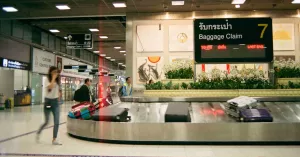When it comes to traveling, there are many different types of luggage options available. From backpacks and suitcases to duffel bags and even plastic bins, the possibilities are endless. However, one option that may surprise you is using a cardboard box as luggage. While it may seem unconventional, using a cardboard box as luggage can actually be a practical and cost-effective solution for certain types of travel.
In this post, we will explore the benefits of using a cardboard box as luggage, how to properly prepare and pack your box, and some important considerations to keep in mind when using this type of luggage.
Cardboard Box Size and Weight Limits
Carry On Box Size and Weight Limits
Cardboard boxes can be brought on board as carry-on baggage if they adhere to the standard rules for carry-on. Your cardboard box must be within size limits, as well as weight limits if imposed by your airline. You also must adhere to liquid restrictions and prohibited items as you would for any carry-on.
Checked Box Size and Weight Limits
Generally speaking, most airlines will accept a cardboard box as checked luggage. In terms of size and weight limitations, they will follow the limits of standard checked baggage:
- Size limit: 62 linear inches (158 centimeters)
- Weight limit: 50 pounds (23 kilograms) or 40 pounds (18.1 kilograms) with some low-cost carriers.
It’s always best to check with your specific airline for its allowances and restrictions on checked baggage.
However, there are a few other things we need to consider when checking in a box:
- A box’s vulnerability to damage.
- Seasonal and year-round restrictions on boxes as checked baggage.
We’ll address these issues further in this article. First, let’s have a look at the pros and cons of using a box as checked luggage.
Benefits of Using a Cardboard Box as Luggage
There are several benefits to using a cardboard box as luggage, including:
Cost-Effective
Using a cardboard box as luggage can be a cheaper option, as you may be able to find boxes for free at local stores or by asking friends and family. I’ve had luck going to bike stores for free boxes.
If you decide to buy a cardboard box, they are generally less expensive than typical luggage.
Flexible and Customizable
Cardboard boxes come in a variety of sizes, so you can choose one that best fits your needs. You can also easily cut and modify the box to make it more comfortable to carry or to fit certain items.
Sustainable
Using a cardboard box as luggage can be a more sustainable option than buying new luggage that may only be used once or twice. Cardboard boxes are also recyclable, so you can easily dispose of them after your trip.
Limitations of Using a Cardboard Box as Luggage
While using a cardboard box as luggage can be a great option in certain situations, there are a few important considerations to keep in mind:
Not as Durable
One of the biggest limitations is that cardboard boxes are not as durable as traditional luggage. They can be easily damaged during transit, which can result in lost or damaged items. Additionally, cardboard boxes are not waterproof, which means that your belongings can be damaged if they are exposed to water or moisture.
Limited Security
Another limitation of using a cardboard box as checked luggage is that they are not as secure as traditional luggage. Cardboard boxes can be easily opened or tampered with, which can put your belongings at risk. This is especially true if you’re traveling with valuable or fragile items.
Limited Protection
While you can customize a cardboard box to add additional padding and protection, it may not offer as much protection as a traditional suitcase. Your belongings may shift during transport and become damaged.
Difficult to Handle
Cardboard boxes may be difficult to handle, especially if they are heavy or bulky. This can be particularly challenging when navigating through airports or transferring between flights.
Preparing and Packing Your Cardboard Box
Before you start packing your cardboard box, it’s important to properly prepare it to ensure that it will hold up during your travels. Here are the steps you should follow:
1. Choose A Strong Box
The first step is to choose the right cardboard box. Look for a box that is sturdy and durable, with thick walls and a secure lid. Make sure the box is the right size for your belongings, with enough room for packing materials like bubble wrap or packing peanuts.
2. Reinforce the Box
You can reinforce the corners and edges of the box by using packing tape.
3. Add a Layer of Padding
To protect your items from damage during transit, add a layer of padding to the bottom of the box. This can be done by using crumpled newspaper or packing peanuts.
Hot Tip: Use some of your clothes as padding inside the cardboard box. You can save valuable space in your other luggage while providing protection for the items inside your box.
4. Pack Your Items
When packing your items, be sure to distribute the weight evenly throughout the box to avoid any shifting during transit. Use bubble wrap or packing paper to protect any fragile items.
5. Add Another Layer of Padding
Once all of your items are packed, add another layer of padding on top to keep everything secure.
Don’t forget to include your contact details inside the box.
6. Seal the Box
Once you’ve packed your belongings, secure the box with strong packing tape. Make sure to tape all seams and corners and reinforce any weak spots. This will help prevent the box from opening or breaking during transit.
Labeling Your Cardboard Box
Labeling your cardboard box is also an important step. This will help to ensure that your items arrive at their intended destination and can be easily found if they get lost or misplaced.
Include Your Contact Information
Be sure to include your name, address, and phone number on the outside of the box. This will make it easy for the airline to contact you if your box is lost or delayed.
Label as Fragile
If you are packing fragile items, be sure to label the box as “fragile” or “handle with care.” This will alert airline staff to be extra careful when handling your box.
Airline Policies on Traveling with Cardboard Boxes
If you plan to travel with a box as checked baggage, it is highly recommended to review your airline’s current checked baggage policy on their website or contact the airline directly. This is especially important if you are traveling anywhere south of the U.S. border.
Also, some airlines have restrictions on the general shape of checked baggage. For example, Qatar Airways will not accept checked baggage that is round-shaped or has an irregular shape.
Checking Your Box at the Airport
Review Your Airline’s Checked Baggage Policy on Boxes
When it comes to checking your box at the airport, there are a few things you should know. First, you’ll need to check with your airline to see if they allow cardboard boxes as checked luggage. Some airlines have specific restrictions or requirements, so it’s always best to double-check before you travel.
You’ll also want to make sure that your box meets the weight and size restrictions set by your airline. If your box is too heavy or too large, you may be charged an extra fee or be required to check it as cargo.
Arrive at the Airport Early
It’s also a good idea to arrive at the airport early, as checking a cardboard box may take a little longer than checking a traditional suitcase or bag. Once you arrive at the airport, simply take your box to the check-in counter and follow the instructions of the airline staff.
Most airlines will require you to sign a release of liability form at check-in for checked boxes, absolving the airline of any responsibility or liability for damage or loss during transit. This is due to cardboard boxes being more fragile and susceptible to damage than standard baggage.
Baggage Embargoes on Boxes
Many U.S. carriers have baggage embargoes to certain destinations, which may include seasonal or year-round restrictions or bans on boxes as checked baggage. Typical restrictions include:
- Only original, factory-sealed boxes are allowed.
- Oversized and/or overweight boxes not permitted.
- Worst case scenario: all boxes are prohibited in checked luggage.
Regions where these restrictions are typically in effect include:
- Latin America
- Caribbean
- South America
We will provide an overview below of the restrictions that you should expect with each airline. We will also include links to dedicated posts for each airline’s baggage embargo rules.
American Airlines
America Airlines applies baggage embargoes to certain destinations which limits the amount and type of checked baggage with which you can travel. One of those limitations is not being able to check boxes as luggage.
Also, American Airlines uses the word, “box” loosely. It applies to any non-conventional luggage container such as:
- Containers
- Coolers
- Plastic tubs
Regions where destinations may be subject to a baggage embargo includes Latin America, the Caribbean, and South America. For example, America Airlines imposes a year-round cardboard box ban for flights to or from Port au Prince, Haiti.
Delta Air Lines
Delta also imposes baggage embargoes on certain regions.
For travel to or from Central America or South America, only boxes which are the original, factory-sealed, manufacturer’s box are allowed. For example, a brand-new television in its original packaging that has not been opened would be acceptable.
There is a year-round ban on boxes as checked baggage to/from the following destinations:
- Brazil
- Chile
- Mexico
JetBlue Airways
JetBlue has baggage embargoes to certain destinations, prohibiting boxes as checked baggage. You can’t travel with cardboard boxes as checked baggage on international flights, except for Cuba. However, your boxes must be the original manufacturer’s packaging, and factory sealed. Between November 16 and January 15, boxes will not be allowed.
If you wish to check a television as checked baggage when traveling domestically within the U.S., your TV must be in the original, factory-sealed packaging.
Southwest Airlines
Southwest has a permanent baggage embargo for travel to or from Cuba. Boxes will not be accepted at check in.
Southwest also has a seasonal baggage embargo, prohibiting boxes as checked baggage, to/from the following destinations:
- Bahamas
- Belize
- Jamaica
- San Jose, Costa Rica
United Airlines
United Airlines’ baggage embargo is less restrictive than most other airlines. There is no total ban of boxes on any route. You can substitute a box as a checked bag as long as it’s no larger than 62 linear inches (158 centimeters) and not weighing more than 50 pounds (23 kilograms).
However, for travel to/from the following destinations, your box can be no larger than 42 linear inches (107 centimeters):
- Mexico
- Caribbean
- Central America
Final Thoughts
Using a cardboard box as checked luggage can be a cost-effective and eco-friendly option, but it also comes with several disadvantages. Before making a decision, it is important to consider several factors, including:
- The limited protection a cardboard box provides.
- Box restrictions on certain itineraries.
- Extra preparation required to pack and seal your box.
- They can be cumbersome to handle as you’re moving through the airport.
If you do decide to use a cardboard box as checked luggage, make sure to reinforce it with extra padding, protect fragile items with bubble wrap or clothes, and label it with your name and contact information.
Remember to always check your airline’s website or contact their customer service for the latest information on baggage allowances and fees.



